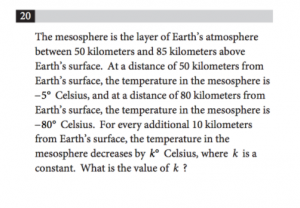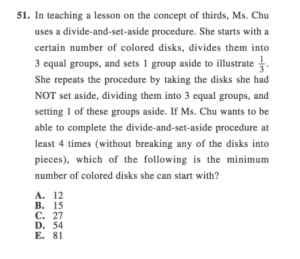
The perennial SAT vs ACT question is one that has boggled students for years now. However, the decision as to which one you should take is simply a matter of how comfortable you are with specific skill sets.
Structure
At a glance, these two tests are very comparable. The SAT consists of:
- Reading comprehension: 5 passages and 52 questions in 65 minutes
- Writing and language analysis: 44 questions in 35 minutes
- Non-calculator math: 20 questions in 25 mins
- Calculator math: 38 questions in 55 mins
- An optional essay: 50 minutes
Meanwhile, the ACT consists of:
- English: 75 questions in 45 mins
- Math: 60 questions in 60 mins
- Reading comprehension: 40 questions in 35 mins
- Science: 40 questions in 35 mins
- An optional essay: 40 minutes
Thus, both tests have grammar, math, reading and an essay.
However, there is nuance to the skill sets tested between these two college admissions tests.
Writing and Language/English
The rhetoric tested in the English language analysis sections of these tests have different emphases. The SAT is more focused on writing style, includes charts and graphs, and challenging vocabulary. The ACT instead focuses on rhetoric questions that address the big picture as well as on grammar and conventions. Students who feel less comfortable with using data in order to write or interpret essays would feel more at ease with the ACT’s English section.
Another difference between the ACT and SAT has a more psychological impact: timing.
While 44 questions are somewhat manageable within the 35-minute time frame of the SAT, the 75 questions on the 45-minute ACT English section leaves students fatigued. Attrition is a huge factor.
It is also important to remember that this 75 question-section is the first one on the ACT, which means that the student encounters this barrage of questions right before moving onto 60 math questions, four reading passages, and seven science passages. This is not ideal for someone who has trouble maintaining a certain amount of mental stamina.
In short, in order to pick between the SAT and ACT, students must first decide whether or not they would like to take on the Herculean task expected of them on the ACT English section.
Math
For math, both tests focus on algebra I and II, geometry, problem-solving, and statistics to varying degrees. The emphasis on problem-solving and data analysis is higher on the SAT as compared to the ACT, while the emphasis on geometry is slightly higher on the latter.
Furthermore, while the SAT focuses on the basic math concepts encountered in Algebra I, Algebra II and geometry, the ACT includes concepts as difficult as permutations/combinations and matrices. However, these last two concepts are very learnable, with the help of a few key rules.
Generally, the math on the ACT is more straightforward than that on the SAT.
Here’s an example of a word problem on the SAT:

The basic concept needed to understand and do such a problem is a simple one: slope. If we find the rate of change in temperature per change in 1 km of altitude, and then multiply by 10 to find the change in temperature per change in 10 km of altitude, we have the answer. However, it takes a while for the student to come to this understanding because the questions never mentions the math concept that is needed.
Contrast this with an advanced level word problem on the ACT:

Sure, the problem is pretty lengthy. However, once we get past that and really focus, the objective is pretty clear: find the minimum number of disks such that we can divvy them up in this manner four times. Well, the most basic way to do this would be to make a diagram.

Now, let’s not let this picture mislead us: we do not start with three disks. However, each dot gives us a sense of the number of groups. We want this such that, at the end of four reiterations of such branching, we have an integer number of disks in each group. What’s more is that we want to find the least number of disks needed after four reiterations of this branching. Well, that would mean that after four reiterations, we want one disk in each group.
Thus, another way to conceptualize this problem is that if we keep splitting these into groups of three, and if we want four reiterations, we need to find 34.
A tricky concept, but we are able to do it after either visualizing or using our calculator (which is allowed on the one ACT Math section.)
So for tricky concepts with straightforward objectives, take the ACT. For basic concepts with more roundabout questions, take the SAT.
Reading
This is another section with stark timing differences between the SAT and ACT. Notice how the SAT provides 5 passages in 65 minutes, while the ACT does 4 passages in 35 minutes.
Students have 13 minutes for each SAT passage and only 8 minutes and 45 seconds for each ACT passage. In fact, the pacing expected of students on the ACT is similar to that expected of LSAT test-takers.
To make matters worse, the typical SAT passage is 500-750 words while the typical ACT passage is about 1000 words.
That said, the ACT passages and questions are more straightforward than those on the SAT.
The SAT has four reading “topics”: science (of which there are two passages), founding documents (or primary source passages), literature, and social studies.
The ACT also four topics: literature, humanities, social studies, and science.
The SAT founding document has become an infamous theme. Previous passages have ranged from the Lincoln-Douglas debates to Virginia Woolf’s thoughts on women engaging in institutions created by men. On such passages, the language is often anachronistic, and the concepts themselves are often tricky. Sure, Alexis de Tocqueville doesn’t believe that a society where men and women are fully equal is a good one, but what does he concede about America? What is Edmund Burke even trying to say in Reflections on the Revolution in France?
If you’re ready for this, as well as for a greater proportion of inference-based questions and tricky answer choices, consider the SAT.
If you’re ready for reading and interpreting more straightforward passages while racing the clock, consider the ACT.
Essays
The SAT and ACT essays are optional. This is important to establish at the outset. Check the application requirements for the schools to which you are applying to see if you need to take the test with the essay.
The essay on the New SAT is interesting. For those of us who took the SAT before 2015, the task was simple: read a quote or analysis on some aspect of everyday life and reply with your (well-organized) thoughts.
The new SAT is different – you do not need any background information or references. Do not bring up any anecdotes or any outside knowledge.
The essay is now a rhetorical analysis. You will be provided with the same directions every time:

You will then read the passage. This will be an article or speech taken from any source.
Below is an example prompt, the format of which is the same on every test:

This is different from the ACT, where you will write an argumentative essay. You be prompted with an analysis of some issue, and three differing perspectives on it. Topics have ranged from education to environmentalism. Below is an example of an ACT essay prompt:

Conclusion
In short, a student’s affinity for the SAT or the ACT boils down to their comfort with timing, section length, and inference-based questions. That said, it is highly recommended to take practice tests for both test types, to gain a better sense for which is best suited to you.

